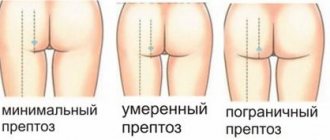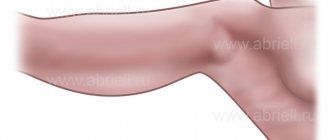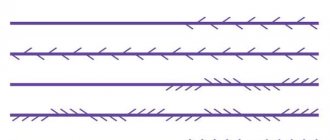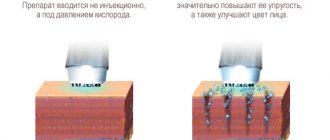More about body plastic surgery...
Thigh lift / Upper body lift /
Butt lift . In this article we will talk about tightening the gluteal region. You will learn what modern methods of carrying out this procedure exist today. We will also talk in detail about the causes of ptosis (drooping) of the buttocks and methods of combating such a cosmetic defect.
Having beautiful, toned buttocks is every woman’s dream. However, it is not always possible to achieve the desired result with exercise and diet. Sometimes the shape of the buttocks is not so attractive by nature, due to the physiological characteristics of the body. But most often, correction of problem areas is required after rapid weight loss, after pregnancy or age-related changes. Many women begin to feel embarrassed about their buttocks, try to hide defects under clothes, and do not visit swimming pools, saunas, or beaches. Today there are several ways to solve this problem. Plastic surgery as a science does not stand still. Every year, scientists are developing new methods for correcting the human body, and it should be noted that they are making significant achievements in this area! You can restore or acquire a beautiful shape of the gluteal region through conservative and surgical methods. It all depends on the degree of ptosis (sagging skin flaps).
Butt lift. What does it represent?
A butt lift is a medical procedure that is aimed at correcting the shape, size, and volume of the buttock area. Most often, representatives of the fair sex deal with this problem, especially after the birth of a child or rapid weight loss. However, buttock lifting is also quite popular among men. Sagging tissues are difficult to tighten with the help of physical exercises, diets, and the use of cosmetics. Especially if ptosis has developed to degree 3-4. Therefore, the most effective method is plastic surgery or lifting with threads and fillers.
Postoperative period
After a butt lift, you should adhere to the usual rules of behavior after plastic surgery.
The operated patient is placed in a rehabilitation ward, where she will remain for a certain time under the supervision of experienced clinic staff. There is no severe pain after this operation, and what pain there is can be relieved with painkillers. On the first day you need to stay in bed. The next day after the operation, after finishing the dressing and breakfast, as a rule, the patient leaves the clinic. After a few days, the recovery process will be more noticeable and you will feel much more comfortable and comfortable. Postoperative compression garments must be worn for a month.
| EVENT | HOW LONG AFTER THE OPERATION CAN THIS BE DONE? |
| Take a shower | 1 day |
| To drive a car | 4 weeks |
| Going to work | 2-4 weeks |
| Removing stitches | 2 weeks |
| Sex life | 2 weeks |
| Sunbathe in the sun or in a solarium | 3-4 weeks until bruises disappear |
| Stop wearing compression garments | 1 month |
| Fitness with a gentle load | 2 weeks |
| Pool | 2 weeks |
| Mandatory follow-up visit to the doctor | 2 months |
A visit to a cosmetologist and massage therapist after buttock surgery is welcome, but there are certain restrictions. Before starting the procedure, inform the specialist that you have had surgery.
| EVENT | HOW LONG AFTER THE OPERATION CAN THIS BE DONE? |
| Lymphatic drainage body massage | 2 weeks |
| Cosmetological body care, wraps | 2 weeks |
| LPG massage | 2 weeks |
| Body peeling | 2 weeks |
Causes of ptosis of the gluteal region:
- Sudden weight loss. When a person intensively loses weight and loses 10 or more kilograms, the skin and muscles do not have time to adapt to new conditions. Therefore, ptosis of skin flaps occurs, which lose elasticity and become “flabby”;
- After pregnancy. Most often, sagging tissue occurs after 2-3 births, especially when the interval between pregnancies was no more than two years;
- Poor nutrition. The daily requirement of fats, proteins and carbohydrates should correspond to the following proportions: 1:1,2:4. The predominance of some substances and the lack of others can lead to various consequences, including changes in the shape of the gluteal region;
- Neglect of physical exercise. Sport should be in every person’s life, even if only the bare minimum. You can run for 10-15 minutes three times a week, do exercises in the morning, go to the pool, go to fitness, and much more. The main thing is to always be in good shape and maintain the beauty of your body;
- Heredity. More often, this reason is associated with poor tissue elasticity, which is passed on from generation to generation;
- Age-related changes in the body.
As you can see, there are many reasons for the development of ptosis of the gluteal region. Therefore, you should not be ashamed of this cosmetic defect, especially if it is possible to correct it.
Surgery
A surgical buttock lift is performed under general anesthesia. Before the start of surgery, some patients require premedication, which is often carried out a day before the procedure. During the operation, a soft tissue incision is made along the gluteal groove or horizontally. After which the surgeon removes skin flaps, subcutaneous fat (if required) and restores muscle tone. Upon completion of the procedure, a cosmetic suture is applied, and sometimes drainage tubes are left in place for 3-4 days.
The benefits of surgery are obvious. Firstly, this is a lasting effect, which, if all recommendations are followed, lasts a lifetime. Secondly, the opportunity not only to tighten tissue, but also to remove excess. Thirdly, even the most complex defects can be corrected.
However, surgical intervention has its disadvantages:
- Not every patient can undergo surgery due to existing contraindications;
- The operation is performed under general anesthesia, which in itself has a negative effect on the body;
- The duration of the procedure can exceed 3-4 hours;
- Small scars remain;
- If you want to change the shape of your buttocks significantly, you will need implants.
How round buttocks are created
It seems that the easiest way in this case is to buy push-up panties with foam pads that will add volume to the buttocks. Unfortunately, with this accessory it is impossible to make love or go to the beach.
To create round buttocks, we at Platinental have developed a unique procedure - the Brazilian butt lift.
Correction of hips and buttocks is done with your own fat
. First, liposuction is performed in the waist area. Excess fat is removed from there, and the waist is made thin. And then - attention! – this fat is injected into the buttocks in a special way to give them the necessary shape and volume.
Using special threads
Using special threads, skin flaps can be tightened. To do this, the material is injected under the skin, capturing soft tissues and ligaments. The threads have special devices on their surface (which grab the fabric and pull it along). The result is the desired effect. The advantages of this method of lifting are as follows. Firstly, no anesthesia is required; the procedure is performed under local anesthesia. Secondly, there are practically no contraindications. Thirdly, the desired result is achieved within 1-2 hours. Among the disadvantages of the method, one can highlight the instability of the resulting effect.
How does filament lifting work?
The technique is not complicated. Takes about an hour. You must first consult a doctor to determine the problem, find out contraindications, assess the fat layer and skin type. Next, the surgeon determines the areas where the threads will be inserted, making marks. Due to the simplicity of this procedure, only local anesthesia is used. Using a cannula, a thread is inserted and secured, and excess material is cut off. Ice is applied to relieve swelling. Depending on the degree of neglect, from 8 to 25 threads are inserted into the buttock.
This procedure receives many positive responses from patients, but, as with any surgical intervention, complications are possible.
- This may be thread cutting, when the result is not noticeable because the thread has passed through the fatty tissue.
- Contouring threads - shifting and probing the material.
- Due to the retraction of the material, the result is unsightly.
- If the threads are rejected, everything must be removed.
There are several contraindications, in the presence of which doctors do not recommend resorting to thread lifting.
Lipofilling
This procedure involves inserting the patient’s fatty tissue under the skin of the buttock area. Thanks to this method, you can globally change the shape of the buttocks and tighten the skin. Fat tissue is taken from other areas, which also corrects the figure. The advantages of the technique are obvious. Firstly, this butt lift is simple and quick. Secondly, local anesthesia is used. Thirdly, low invasiveness.
However, this procedure has disadvantages:
- Achieving the desired result is often combined with other methods;
- Thin people have difficulty obtaining fat tissue;
- Adipose tissue reserves have a limited shelf life.
Contraindications:
- Decompensated conditions;
- Diabetes;
- Inflammatory skin diseases;
- Blood diseases;
- Infectious diseases are at their peak;
- Pregnancy and breastfeeding period.
Rehabilitation
After carrying out any of the above procedures, it is necessary to follow the recommendations of specialists. At first, visiting a sauna, steam bath, or hot bath is contraindicated. It is better to wash in the shower for no more than 15 minutes. You should also try not to sleep on your back and not lift weights for 1-2 months. Lubricate surgical wounds with special solutions prescribed by the doctor. It is also recommended to carefully follow a special diet and engage in any kind of sports.
A butt lift is an effective way to regain a beautiful figure. And with the help of new developments in plastic surgery, this will not be difficult.
The cost of plastic surgery can be found in the “Prices” section.
You can make an appointment by calling +7 (495) 505-5235, +7 (901) 745-4775 at any convenient time from Monday to Friday 09-30 to 17-00.
We will be happy to help you!
Copyright information...
Attention! Any copying or distribution of this content is prohibited. Unauthorized copying and use of text entails legal liability:
— civil liability for copyright infringement in accordance with Articles of the Civil Code of the Russian Federation No. 1252 (“Protection of exclusive rights”), 1253 (“Responsibility of legal entities and individual entrepreneurs for violations of exclusive rights”); — administrative liability for copyright infringement in accordance with Article of the Code of Administrative Offenses No. 7.12 (“Violation of copyright and related rights, inventive and patent rights”); — criminal liability for copyright violation in accordance with Article of the Criminal Code of the Russian Federation No. 146 (“Violation of copyright and related rights”).
Close text.
Beautiful, toned buttocks have always been a source of pride for their owners and the envy of those who do not have such roundness. World-famous beauties with “Brazilian butts” shatter the hearts of the stronger sex, or, at least, cause tachycardia in them due to the release of large amounts of adrenaline. Many ladies spend a huge amount of time in the gym, trying to achieve or restore their former elasticity and volume to their buttocks. However, physical exercises, cosmetic procedures and massages are not always able to restore what was lost or acquire something that was not given by nature. There are constitutional features of the figure for which conservative methods are, in principle, not effective. In such situations, plastic surgery comes to the rescue.
Today, there are several methods in the arsenal of aesthetic surgery to improve the shape of the buttocks, increase their volume and give the necessary elasticity:
— thread lifts (Siluet-lift, Tissulift and others);
- surgical braces;
— installation of implants (endoprosthetics of the buttocks);
— fatgrafting (lipofilling) of the buttocks or, as this method is also called, Brazilian buttock lift.
Regular readers of this site are familiar with some methods of thread lifts from the author’s previous reviews (see the article “What are thread lifts”). As for fat grafting of the buttocks, this is a separate big topic that we hope to cover in the future on the pages of this site.
In today's review, we will touch upon the anatomy of the gluteal region, ptosis and the mechanisms of its formation, and talk about correction methods - surgical buttock lifts.
These issues are not sufficiently covered in the domestic literature and therefore, in our opinion, are of great interest to the reader. Part 1. Anatomy of the gluteal region
So, the skeleton of the buttocks is made up of the pelvic bones, the connections between which are provided by dense ligaments, indicated in this figure:
1 - iliolumbar ligament;
2 – interosseous sacroiliac ligaments;
3 – sacro-osseous ligament;
4 – sacrotuberal ( tuberal – ischial tuberosity) ligament;
5 – superior posterior spine of the iliac crest;
6 – posterior sacroiliac ligament ( Fig. 1
).
The pelvic bones are covered with muscles, over which lies a layer of subcutaneous fat. In particular, this figure shows the large (m.gluteus maximus), and above it the middle (m.gluteus medius) gluteal muscles ( Fig. 2
).
The following figure shows the gluteus maximus ( Fig. 3
a
) and gluteus medius (
Fig. 3 b
) muscles in isolation. Both of these muscles make up the so-called superficial muscle layer.
Beneath the superficial muscle layer is a deep layer consisting of several individual muscles (Fig. 4
).
For greater clarity and consideration of the deep muscles of the gluteal region, it is necessary, relatively speaking, to fold back the gluteus maximus muscle (1 a and 1 b in Fig. 4).
Next: 2 – the middle and, behind it, the gluteus minimus muscles;
3 – pyramidal;
4 – superior twin (m.gemmelus);
5 – internal obturator (m.obturator);
6 – lower twin;
7 - external obturator muscle.
Innervation of the gluteus maximus muscle is carried out through branches (
Fig. 5
- 1, 2, 3, 4) coming from the greater sciatic nerve (6).
Number 5 is the pyramidalis muscle,
from under which the sciatic nerve emerges (6);
7 – coccygeal-tuberal ligament;
8 – ischial tuberosity (tuberal);
9 – greater trochanter (trochanter major) of the femur (Fig. 5).
The gluteus maximus and medius muscles are covered with an aponeurosis (a dense connective tissue membrane), over which lies a layer of subcutaneous fat. The uniformity and thickness of this layer determine the smoothness of the transition of the contours of the buttocks ( Fig. 6
).
There is another important anatomical formation in the gluteal region that is crucial in the formation of ptosis - the subgluteal groove, above which the gluteal fold is formed and held in place. The subgluteal groove is an integral part of the supporting system of the buttocks and is a fusion of the skin and periosteum in the area of the ischial tuberosity (see Fig. 5, No. 8
) through dense connective tissue structures.
Conventionally, these tight fusions can be called the gluteal ligament, which is part of a single ligamentous supporting system of the buttocks ( Fig. 7
).
Figure 7. Gluteal ligament in profile
Multiple dense connective tissue fibers connect the ischial tuberosity and the skin at the very bottom of the buttocks. This structure is responsible for the formation of the gluteal fold and separates the thigh from the gluteal region.
The suspensory ligamentous system of the gluteal region was first partially described by the French surgeon Hypolite Morestin in 1896. He believed that this ligament extends only in the area of the intergluteal fold and perineum due to the fusion of the skin and bone structures of the pelvis through dense connective tissue fibers. In fact, it is a semicircular system that starts from the superior anterior iliac spine, goes through the pubic joint, the perineum, through the ischial tuberosity and ends in the sacrococcygeal joint. Figuratively, this ligamentous fixation system can be represented as a wide, very dense band surrounding the thigh and connecting the pelvic bones and skin. It is surprising that the designers who developed a model of very tight tights with a tightening and supporting effect on the buttocks, probably intuitively, without having a deep knowledge of the anatomy of this area, emphasize and strengthen the ligamentous apparatus described above in their models.
From the above, the following conclusions can be drawn:
1. The supporting ligamentous system is not directly related to the muscles of the buttocks and thighs. That is, it cannot be strengthened through physical exercise.
2. This very important anatomical formation, which supports and preserves the shape of the buttocks, cannot be destroyed. Rupture of the supporting ligaments (for example, when performing aggressive liposuction in this area) leads to destruction of the ligamentous apparatus and, as a consequence, to ptosis of the buttocks ( Fig. 8
).
Ptosis of the buttocks after aggressive liposuction in the area of the upper part of the posterior thigh and gluteal fold.
In the thickness of the subcutaneous fat layer there are many connective tissue transverse bridges (trabeculae), ensuring the compactness of the adipose tissue, low mobility and elasticity of the skin ( Fig. 9
). Subcutaneous fat is divided into a superficial layer (with more densely and compactly lying fat cells), a middle and deep layer (with large, loose fat cells).
Part 2. Causes of development and classification of ptosis of the buttocks
With age, as well as due to decreased muscle tone, sudden weight loss, due to hormonal disorders and changes, connective tissue bridges consisting of collagen and elastin lose their elasticity and stretch. In parallel with this, the volume of fat cells may decrease. These factors together lead to increased mobility and downward displacement of the skin-fat layer under the influence of gravity. In a word - to the occurrence of ptosis ( Fig. 10)
.
a – normal, b – ptosis of the buttocks
The medical term ptosis of the buttocks was introduced by the famous Brazilian plastic surgeon Raul Gonzales. In his opinion, ptosis of the buttocks is excess skin and soft tissue of the gluteal region, which descends below the subgluteal groove.
Ptosis of the buttocks can be congenital (as a feature of the anatomy) and acquired due to sudden weight gain/loss, as well as due to loss of tissue elasticity and firmness with age and hormonal disorders. The buttocks settle slowly, forming a gluteal fold, the length of which gradually increases from the inner edge of the thigh to the outer. In order to determine the presence of ptosis and its degree, it is necessary to evaluate 2 projections:
The first criterion is the evaluation of the photograph from the front. On the rear projection in front, it is necessary to conditionally draw a line that will divide the posterior surface of the thigh into 2 halves - the posterior midline of the thigh (line M) and extend it to the buttocks. The second vertical line must be drawn from the ischial tuberosity (tuber) to the sacrum. In the diagrams proposed by R. Gonzales, this is the so-called T-line. Ideally, the frontal projection of the gluteal fold should not be visible or extend beyond the posterior midline of the thigh. As ptosis of the buttocks progresses, the fold lengthens and in the initial stage extends beyond the midline of the thigh, and then continues to the lateral (outer) part of the thigh.
In this diagram (Fig. 11)
There is no ptosis - this is the norm. There is no gluteal fold at all or it only reaches the T line of the ischial tuberosity.
Minimal preptosis ( Fig. 12
) – the gluteal fold crosses the T-line of the ischial tuberosity, but does not reach the midline of the thigh
- M.
Moderate preptosis ( Fig. 13
) - the gluteal fold reaches the midline of the thigh, but does not cross it.
Borderline preptosis ( Fig. 14
) – the gluteal fold crosses the midline of the thigh.
True ptosis of the buttocks ( Fig. 15
) – the gluteal fold is pronounced and crosses the midline of the thigh at a considerable distance.
The degree of ptosis is determined by a ruler, which is placed in the subgluteal groove and the descent of the gluteal fold is assessed in centimeters ( Fig. 16
).
I degree – descent of the gluteal fold 0.5 cm below the subgluteal groove;
II degree – by 1 cm;
III degree – 2 cm or more.
The second criterion is profile evaluation. From an aesthetic point of view, it is important to evaluate the femoral-gluteal angle in the profile projection. To do this, it is necessary to connect two conditional lines: the 1st - passes through the point of maximum convexity of the buttocks, and the 2nd - the line of the back of the thigh ( Fig. 17
).
As a result, an internal angle is formed, which ideally should not exceed 45 degrees.
Acceptable (no ptosis of the buttocks) values of the femoral-gluteal angle in the profile projection are no more than 90 degrees.
As ptosis of the buttocks progresses, this angle will be more than 90 degrees. Accordingly, the more obtuse the angle is formed, the longer the gluteal fold in the front view and the greater the degree of ptosis.
Part 3. Methods of surgical correction of the buttocks
To correct congenital or acquired ptosis of the buttocks, a surgical buttock lift technique is used, which has several varieties: upper, lateral, medial (“Batterfly”) and the so-called DTA lift.
The main problems that can be solved with the help of surgical braces:
— elimination of ptosis (drooping of the soft tissues of the buttocks);
— elimination of tissue sagging;
— elimination of excess skin of the buttocks;
— formation of new outlines and improvement of existing forms.
The buttock lift technique is selected individually for each patient, depending on the structural features of the buttocks, pursues various goals and is used to lift different areas of the buttocks, as well as the outer thighs. In the diagrams below, solid lines indicate skin incisions, between which de-epidermization (removal of the surface layer of skin) of skin-fat flaps will be performed. They will further play the role of autoprostheses. The dotted line indicates possible levels of detachment of the skin-fat flap (see below for more details).
Upper (according to Pascal or Louran) lift ( Fig. 20
) sets itself the task of tightening the upper-outer sections of the buttocks and thighs, and also allows you to create roundness in the upper sections of the buttocks. The technique is effective for significant ptosis of the buttocks and sagging tissue in the “breeches” area.
With a lateral lift (Fig. 21) (solid lines of incisions in the flank area), the situation with moderate sagging and flabbiness of soft tissues and skin in the area of the trochanters (large tuberosities of the femur), that is, the outer buttocks and upper-outer thighs, improves.
And with the help of a lower DTA-lift (dermo-tuberalanchorage - formation of skin attachment to the ischial tuberosity), indicated by solid lines in Figure 21
in the area of the gluteal fold, you can re-form the subgluteal groove (if necessary), correct excessively elongated buttocks, eliminate asymmetry and mild ptosis, sagging of the lower part of the buttocks.
Medial (Batterfly") – ( Fig. 22
) allows you to eliminate mild or moderate ptosis of the buttocks.
The main feature of modern methods of gluteoplasty is that in addition to tissue tightening, it is possible to additionally add volume through autoaugmentation, that is, the creation of autoprostheses from excess of one’s own tissues. This method of operation was first proposed by the famous French plastic surgeons Claude Le Laurent and Jean Louis Pascal. They have shown the benefits of preserving the patient's own tissue to improve the shape of the buttocks and restore lost volume. The previously used methods of traditional dermolipectomy (removal of a skin-fat flap) did not give the desired result, and the buttocks still remained flattened, except that the skin seemed more taut and smooth.
Based on the authors’ own experience of this article, the “Batterfly” buttock lift method was most often used in practice. For better understanding and greater clarity, we will dwell in detail on the description of this method of operation.
This technique did not receive its name by chance. The pattern marked before the operation really resembles the wings of a butterfly (Fig. 23).
Preoperative marking
Below is the operation diagram:
After making skin incisions along the intended lines and de-epidermization (removal of the surface layer of skin) on the selected “islands,” the ends of the skin-fat flap are separated and turned towards each other (Fig. 24 a). The latter are stitched together, forming an “autoprosthesis” (Fig. 24 b). This stage of the operation can be reminiscent in its technique of making dumplings, when the corners of the dough are brought together and molded to obtain a completed shape.
The released skin-fat “flap” below the selected “islands” covers the formed “autoprosthesis” ( Fig. 25 a
– shown by an arrow), and the edges of the skin wound are sutured together (
Fig. 25 b
).
Thus, in accordance with the technique of this operation, the skin-fat flap is not simply cut out and removed as redundant, but an “autoprosthesis” is formed from it. Thanks to this surgical technique, in addition to tightening the skin, it is additionally possible to increase the projection, fill the upper part and recreate the lost volume of the buttocks.
Technique and stages of surgery
The buttock lift surgery is performed under combined anesthesia (epidural and drug sleep) and takes from one and a half to two hours. Before the operation, marking is carried out, the proposed area of the skin-fat “island” is outlined, from which the “autoprosthesis” will be formed ( Fig. 26
). We will not dwell in detail on the principles of preoperative marking, so as not to overload readers with unnecessary information.
Photos of the stages of the operation
Preparing the operating team for the start of the operation.
Skin incisions were made according to the intended pattern and the skin-fat “flap” below the “islands” was peeled off.
The stage of de-epidermization of the skin (removal of its surface layer) has been completed.
Checking the sufficiency of the boundaries of the detachment of the “flap of skin-fat”, which should cover the deep-epidermised “islands”. In this case, the upper and lower edges of the skin wound should freely reach each other without any significant tension.
The inner (medial) edge of the de-epyremized flap – the “butterfly wing” – is shown, separated from the aponeurosis of the gluteus maximus muscle. The outer edge of the “butterfly wing” is separated in a similar way. This selection of edges must be carried out very carefully and carefully - it is necessary to maintain sufficient vascular nutrition of the “island”, carried out by perforating (penetrating from the depths) arteries.
The edges of the “island” are released, turned inward and stitched together, as shown in the diagram in Figure 24. This photograph shows that an “autoprosthesis” has already been formed on the left half of the buttocks, resembling an oval in shape. On the right half of the buttocks, the formation of the flap is not yet completed.
The stage of forming autoprostheses on both sides has been completed.
The “flap” of the skin-fat flap covers the “autoprosthesis” formed by the surgeon. The photo shows that the upper and lower edges of the wound are compared to each other with temporary adapting sutures.
The operation is completed, the wounds are sutured in several rows, with an intradermal continuous suture. Active drains (tubes) are installed in the lower part of the buttocks.
Profile view of the buttocks after completion of the operation. The projection and volume of the buttocks have increased significantly, the gluteal fold has smoothed out, the skin is taut and smooth.
This is not a public offer! There are contraindications. Before use, consultation with a specialist is required.
As a rule, after surgery, patients remain in the hospital for one day, and then visit the surgeon for dressing changes on an outpatient basis. It is necessary to wear compression garments for 3-4 weeks, limit physical activity, hot procedures, visits to baths, saunas for 1.5-2 months. Sutures are removed 7-10 days after surgery.
With the lateral and superior lift according to Pascal or Louran, the same techniques are used to form “autoprostheses”. The only difference is the location of the incisions on the skin. Therefore, we did not consider it necessary to go into detail about these butt lift methods.
The technique of the DTA (lower) lift operation has several fundamental differences from previous techniques. And we will be happy to tell you about the nuances of this operation.
Let us remember that the main goal of the DTA lift technique is to form a new subgluteal fold, eliminate asymmetry and excessive elongation of the buttocks, and eliminate sagging in the lower part.
To do this, according to the intended preoperative markings, deep-epidermization of the skin area in the area of the subgluteal fold is carried out. Using a special dye, in this case brilliant green, the surgeon marks a horizontal line dividing this area in half ( Fig. 37
).
A strong non-absorbable thread grasps the upper edge of the deep-epidermalized area, then the thread passes through the dense tissue above the ischial tuberosity and comes out to capture the lower edge of the deepedermalized area (Fig. 38). Several such strong holding sutures are applied along the wound (4-5 pieces). Then all the threads are tied one by one. In this way, a strong attachment of the skin to the dense tissues of the ischial tuberosity is created, a new subgluteal fold is formed, the length of the buttocks is reduced and their lower part is tightened.
This photograph shows the final stages of the operation - suturing the subcutaneous tissue ( Fig. 39
a
) and skin (
Fig. 39 b
).
Using the example of one of our patients, we will demonstrate the result of a DTA butt lift after unsuccessful liposuction in the subgluteal groove area. Let us recall that the reasons for the “collapse” of the buttocks after liposuction in this area were described at the beginning of the article.
Before and after DTA lift (front)
Not a public offer! There are contraindications. Before use, consultation with a specialist is required.
Before and after DTA lift (semi-profile)
This is not a public offer! There are contraindications. Before use, consultation with a specialist is required.
Before and after DTA lift (semi-profile)
This is not a public offer! There are contraindications. Before use, consultation with a specialist is required.
Postoperative sutures are shown (after 1 year)
This is not a public offer!
There are contraindications. Before use, consultation with a specialist is required. At the end of the article, we would like to add that in some situations (with an initially pronounced deficiency of soft tissues and a significant excess, sagging skin), in order to obtain the maximum aesthetic result - increasing the volume and projection of the buttocks, it may not be enough to perform only a surgical lift. In such cases, it is necessary to combine it with other methods: for example, endoprosthetics, thread lifting or fat grafting.
Creating the ideal shape of the buttocks is a creative process for the surgeon, akin to art. A deep understanding of the anatomy of this area, the mechanisms of ptosis formation and correct aesthetic perception will allow the surgeon to choose from among the many surgical techniques exactly the method of correction that will lead to achieving the optimal result.
Note: in this review, drawings and photographs were used from the books R. Gonzales “Buttocks reshaping” (2006) and Constantino Mendietta “The Art of Gluteal Sculpting” (2010), as well as the author’s diagrams and photographs from his own archive.
To communicate with patients who have undergone buttock surgery, come to our forum in the section Other plastic surgeries in the body area









